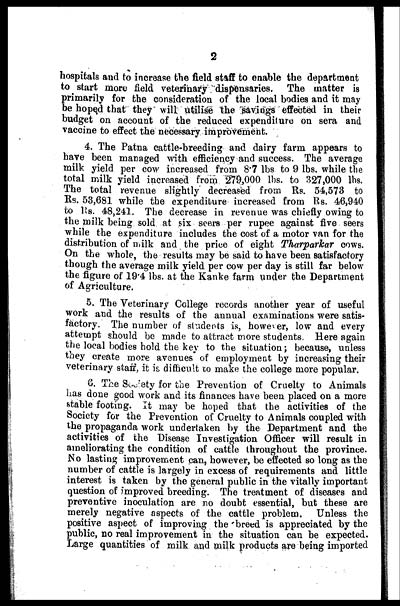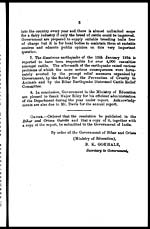Medicine - Veterinary > Civil Veterinary Departments > 1911-1936 - Annual report of the Civil Veterinary Department, Bihar and Orissa > 1929-1936 - Civil Veterinary Department Bihar & Orissa reports 1929-36 > 1932-1933 - Annual report of the Civil Veterinary Department Bihar and Orissa for the year 1933-34
(407) Page 2
Download files
Individual page:
Thumbnail gallery: Grid view | List view

2
hospitals and to increase the field staff to enable the department
to start more field veterinary dispensaries. The matter is
primarily for the consideration of the local bodies and it may
be hoped that they will utilise the savings effected in their
budget on account of the reduced expenditure on sera and
vaccine to effect the necessary improvement.
4.The Patna cattle-breeding and dairy farm appears to
have been managed with efficiency and success. The average
milk yield per cow increased from 8.7 lbs to 9 lbs. while the
total milk yield increased from 279,000 lbs. to 327,000 lbs.
The total revenue slightly decreased from Rs. 54,573 to
Rs. 53,681 while the expenditure increased from Rs. 46,940
to Rs. 48,241. The decrease in revenue was chiefly owing to
the milk being sold at six seers per rupee against five seers
while the expenditure includes the cost of a motor van for the
distribution of milk and the price of eight Tharparkar cows.
On the whole, the results may be said to have been satisfactory
though the average milk yield per cow per day is still far below
the figure of 19.4 lbs. at the Kanke farm under the Department
of Agriculture.
5.The Veterinary College records another year of useful
work and the results of the annual examinations were satis-
factory. The number of students is, however, low and every
attempt should be made to attract more students. Here again
the local bodies hold the key to the situation ; because, unless
they create more avenues of employment by increasing their
veterinary staff, it is difficult to make the college more popular.
6.The Society for the Prevention of Cruelty to Animals
has done good work and its finances have been placed on a more
stable footing. It may be hoped that the activities of the
Society for the Prevention of Cruelty to Animals coupled with
the propaganda work undertaken by the Department and the
activities of the Disease Investigation Officer will result in
ameliorating the condition of cattle throughout the province.
No lasting improvement can, however, be effected so long as the
number of cattle is largely in excess of requirements and little
interest is taken by the general public in the vitally important
question of improved breeding. The treatment of diseases and
preventive inoculation are no doubt essential, but these are
merely negative aspects of the cattle problem. Unless the
positive aspect of improving the breed is appreciated by the
public, no real improvement in the situation can be expected.
Large quantities of milk and milk products are being imported
Set display mode to: Large image | Zoom image | Transcription
Images and transcriptions on this page, including medium image downloads, may be used under the Creative Commons Attribution 4.0 International Licence unless otherwise stated. ![]()
| Permanent URL | https://digital.nls.uk/76135392 |
|---|



![[Page 1]](https://deriv.nls.uk/dcn4/7613/76135380.4.jpg)
